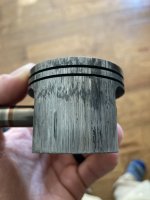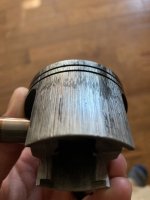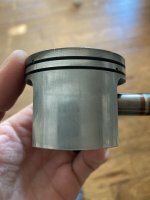spencerdiesel
Well-Known OPE Member
- Local time
- 1:48 PM
- User ID
- 14124
- Joined
- Oct 10, 2020
- Messages
- 98
- Reaction score
- 164
- Location
- Brevard, NC
Thanks! It’s the first fastener I’ve come across that siezed on the way out. I’ll try heat first
In the Stihl book for my 461 it said that "you should not have a pressure loss greater than blah blah blah in 30 seconds" and something similar for vacuum too, fyi. So, while it's not great to have a pressure loss Stihl might allow a slight loss.It shouldn't leak. That said, small leaks at the spark plug or decomp can usually be tolerated since they're not actually affecting air/fuel considerations. They're also common. Anything associated with the integrity of the intake assembly and/or bottom end should be identified and fixed, imho. If you can see the leak on a gauge, you can find it and fix it with enough patience. Some are just a lot more difficult to pin down than others.

Ironically, they originally considered a crankcase airtight if there was no drop in pressure. Any drop in pressure required diagnosis and correction. They still gave some wiggle room to vacuum. Then they loosened their standard to holding o.5 Bar (7.25psi) for 20 seconds during a pressure test..., which is dubious at best if it leaks at all. They now again consider any leak unacceptable, including vacuum.So, while it's not great to have a pressure loss Stihl might allow a slight loss.
Ironically, they originally considered a crankcase airtight if there was no drop in pressure. Any drop in pressure required diagnosis and correction. They still gave some wiggle room to vacuum. Then they loosened their standard to holding o.5 Bar (7.25psi) for 20 seconds during a pressure test..., which is dubious at best if it leaks at all. They now again consider any leak unacceptable, including vacuum.
To put this into perspective, the first thing that needs clarification is how the measurement terms are tossed around and how they relate. So let's clarify that. After initially using kp/sq. centimeter as the form of pressure/vac measurement, they transitioned to the bar method and still use it today, but with PSI and in/Hg now also being referenced in some technical documentation. To more easily understand what our MityVacs are telling us, we generally need to convert what's in the shop manual to what's on the gauge.
0.5 Bar = 7.25psi and 14.76 in/Hg -- vacuum. So if your vacuum rises from o.5 bar to 0.3 in 20 seconds, you've lost nearly 50% of the seal -- in 20 seconds. Make no mistake -- it will continue to leak down to 0 within the next 30 to 60 seconds in almost every instance unless there is a specific seal tolerance that stops the leak at around 0.3 bar / 7~8 in/Hg. (I have actually had that happen on an 045 I recently rebuilt and wrote it off as the proprietary NOS seal that I used.) The same will hold true for pressure in nearly every instance. And while 0.3 bar / 4.3psi may still run a fuel pump diaphragm, anything much less will eventually become a problem.
BTW, I also read in an old-ass Stihl manual somewhere to use a screwdriver to 'gently pry' a crankcase apart. Didn't think that was very good info either! LOL
The thing is, these are usually easy leaks to find and fix. Just fix em or learn how to if you haven't chased too many yet. If you work on saws often enough, you'll find your vac/pressure test setup to be one of your most valuable investments for both fixing stuff right, and your peace of mind when you're done with a job or project. Anything else is just guessing. If you find a leak, fix it.
That's what the MS462 C-M and other new Stihl manuals now tell ya to do.
Sorry for the lengthy post. And not that it's the case here or I'm implying anything, but I just find it curious that some folks will spend more time trying to come up with reasons to NOT do a vac/pressure test than it would take to do one in the first place. Hell, I was that guy many years ago. Just trying to encourage folks to go the extra mile. It becomes routine before you know it.











